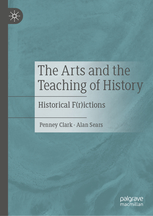Clark, Penney and Alan Sears. The Arts and the Teaching of History: Historical F(r)ictions. New York: Palgrave Macmillan, 2020. (297 pages)
There is significant evidence to show that artistic representations of the past are influential in shaping people’s sense of history and collective memory. Drs. Penney Clark and Alan Sears closely examine the pedagogical possibilities of integrating the arts, in the form of fiction, paintings, and commemorative works, into the history curriculum at the secondary and post-secondary levels.
In Chapter one, “The Place of the Arts in Teaching History,” the authors discuss the ways in which engaging with the arts in history classes will stimulate students’ interest in history, help them to see the connections between history and contemporary concerns and broaden their understandings of and empathy with, historical agents’ circumstances, including motives, desires, ambitions, limitations, and opportunities, and ultimately spark a sense of wonder about the possibilities inherent in studying history. The arts are powerfully engaging, they add another dimension to students’ learning and they help students acquire the skills they need to interrogate different representations for their implicit meanings.
Chapter two, “Five Scholarly Conversations Related to History, History Education, and the Arts,” situates our work within a complex set of five interrelated scholarly conversations around the nature of history and historical truths, the connections between history and the arts, collective memory and historical consciousness, Indigenous perspectives in history education, and implications for history education, including, the ways that individuals and collectives construct narratives about their place in the world and the sources on which they draw in doing so, as well as the implications of constructivism for teaching and learning history.
Chapter three, “Historical F(r)ictions: Fiction and History Education,” explores historical fiction in the form of novels, distinguishing between two types of novels with historical content. Period novels are novels written in a particular time about that time and historical novels, which are written about an earlier time. This distinction has significant implications for history pedagogy. Each must be approached differently if we are to use them effectively as windows into the past. Period novels can be examined for usefulness as primary sources, for what they can reveal about the time. Historical novels can be examined to determine to what extent the author adheres to the historical evidence.
Chapter four, “Beyond Adornment: Visual Art as Source and Account in History Classrooms and Public Spaces,” considers the purpose and place of visual art in the history classroom. A painting or sculpture can convey a particularly vivid sense of a historical period. However, visual representations are not simply traces of the past to be accepted as evidence, but are constructed accounts that reflect the perspectives and purposes of the artist and his or her sponsors.
Chapter five, “Points of Convergence: Public Commemorative Art and the Teaching of History,” is about public commemorative art and the importance of helping students ask questions both about the ideas and values it is designed to disseminate and about who made it, for what purposes and in what contexts. Public commemorative art provides opportunities for students to examine controversies around history and history education.
Chapter six, “Engaging the Fray: Preparing Teachers and Students for Critical Encounters with the Past,” examines the implications of the foregoing discussions for the teaching and learning of history. The chapter explores four implications of current history education research: developing students’ understandings of how art shapes personal and collective historical narratives and how those operate to construct the social world; enhancing students’ abilities to work with a range of historical sources; engaging students with the ethical dimension of the past; and fostering historical perspective taking.
In Chapter seven, “The Humanizing and Civic Missions of History Education” we discuss the ubiquitous nature of artistic representations from the past in the form of historical fiction, visual art, and commemorative art. Engaging the arts in history class fosters: more complex understandings of history and the nature of truth, cross-curricular/disciplinary connections; consideration of the relationship between history, historical consciousness and collective memory; the introduction of Indigenous perspectives; and the development of critical thinking.
Dr. Penney Clark is Professor in the Department of Curriculum and Pedagogy and serves as Deputy Head. Dr. Clark’s research interests centre on the production and provision of elementary-high school textbooks in historical contexts, the historical development of history and social studies curricula in Canada, and history teaching and learning. She has published widely in these areas. Along with Dr. Mona Gleason, Dr. Clark is co-editor of the journal Historical Studies in Education/ Revue d’histoire de l’éducation. Link to her bio.
